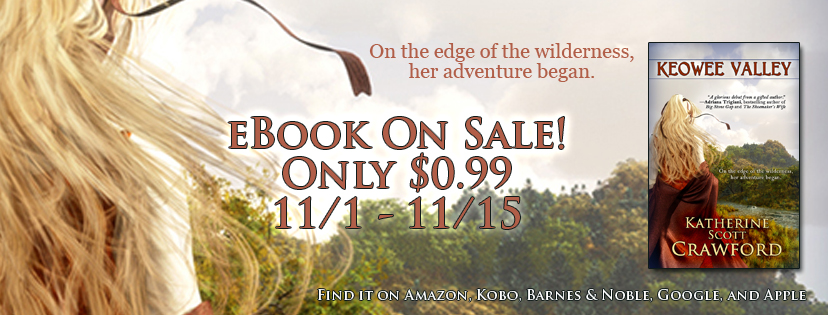What Would Quinn Do?
by Katherine Scott Crawford
Every Autumn, when the mountains around my Western North Carolina town flame with color and the humidity lifts, leaving a sky so crystalline blue it hurts your eyes to look at it, I think of Quinn.
Quinn (or Quincy) McFadden is the heroine of my first historical novel, Keowee Valley. In the 1760s she leaves behind the bustling, international port of Charleston, South Carolina—and her irascible, skeptical grandfather—for a new life in the wild Carolina backcountry. Though Quinn sets out in summer (via carriage, wagon, and foot along the Cherokee Path), it is Fall when the novel opens. In fact, it’s an “Indian summer,” just like the one my part of the world seems to be experiencing this year.
“Indian summer,” according to the experts, is an unseasonably hot, dry Autumn. It was dubbed such because it occurred most in places where Native Americans (or American Indians) lived and hunted. Considering that here in Western North Carolina in 2019, September was hotter and drier than August (the hottest and driest on record), it seems a fitting description.
In the Prologue of Keowee Valley, Quinn looks back on her life, remembering such a time. The Prologue was the start of the novel for me, in more ways than one. It remained virtually unchanged from the time I wrote it until the time it appeared in print, as a published novel. Here’s the first paragraph:
My story begins before the fall, in that Indian summertime when the hills are tipped with oncoming gold, and the light hangs just above the trees, dotting the Blue Ridge with gilded freckles. The mornings and the evenings are cool, but it is the mornings I remember most: waking before the men, wrapping a shawl around my shoulders and slipping out through the fields, the dry grass crunching beneath my boots. Drifting down from Tomassee Knob the mist would spread over the Keowee Valley in a great, rivering pool of gray, the sun rising in the east flecking the horses’ breath—suspended in the air before their nostrils—with slivers of shine. It was then the whole world was quiet, no crows eating my corn, the peacefulness not even broken by the bay of some wolf on the ridge, calling to the still-lit moon in the western sky. The whole world was silent then, and the Blue Ridge breathed beneath the deep purple earth. I thought I could feel it, a great heart beating in the wilderness.
Many times over the years, friends and family members, book club participants or folks in the audience at events where I’ve been a guest speaker, have asked if Quinn is me. I think this is a natural assumption: after all, characters are an author’s creation. But the truth is, while there is much of me in Quinn, she’s made up of the fibers of my experience, and of my inexplicable dreams.
Still, when it comes to Autumn in the mountains, and how she feels about it, Quinn and I are kindred spirits. Quinn craves solitude; she doesn’t mind being alone. On the dangerous Southern frontier, even among the few colonial settlers, the Cherokee people, the plants and animals, Quinn still needs to be alone at times. She is a deep thinker: a stare-out-the-window sort of person.
Just like Quinn, I crave the nature of wilderness—never more so than in Autumn. I am a natural ponderer, and so is she. For the two of us, wild places, and expansive views, invite pondering more than anywhere else.
However, in addition to being a novelist, I am also mother to two young children. When you’re a mom, you just don’t get much stare-out-the-window time, no matter the season. You don’t have much of a chance to ponder on anything except, perhaps, family concerns. But for me—and certainly for Quinn—this is an important part of our personalities. It makes us, us.
This Autumn, I’m determined to be more like Quinn. I long to step away from the overwhelming noise of the modern world, and to stare into a forest full of stories. I want to watch elk graze in a long mountain valley, in meadows the color of old gold. I want to settle myself on a creek bank, consider the play of light on ancient boulders in the water. Even if I have only moments of solitude before my busy life intrudes.
Quinn is my inspiration, though. Because in Quinn’s story, an unusual man crosses that creek to find her, and an epic adventure begins.
***
Katherine Scott Crawford is an award-winning historical novelist, newspaper columnist, and Founder and Director of MountainTop Writers Retreats. An avid hiker and travel junkie, she’s also a former newspaper reporter, backpacking guide, and college professor. She lives with her husband and daughters in the mountains of Western North Carolina, where she is at work on a new novel. Connect with her at www.katherinescottcrawford.com or on social media (especially Instagram @thewritingscott).
Keowee Valley is on sale for $0.99 from November 1st to November 15th. Find it at Amazon, Kobo, Barnes & Noble, Google, and Apple.





